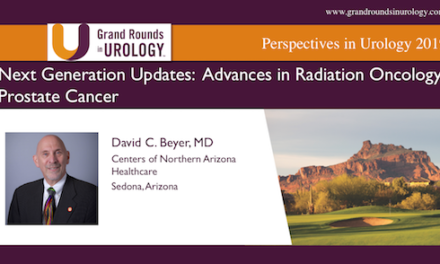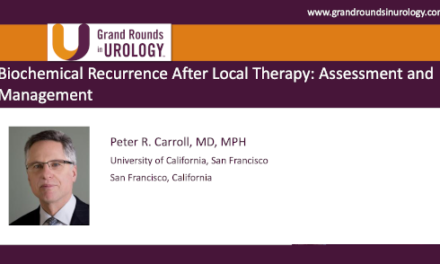
PCa Commentary | Volume 178 – June 2023
Posted by Edward Weber | June 2023
Radioligand Therapy (RLT): A View into the Future — New Regimens Under Study
The outcome of the VISION trial, the first reported study of radioligand therapy (RLT) with the radionuclide 177-Lutetium-PSMA-617 targeting the PSMA antigen now serves as the baseline for further development of this promising treatment. The VISION trial studied 831 heavily pretreated
men with metastatic castration-resistant prostate cancer (mCRPC) (Sartor et al., NEJM 2021) with at least one PSMA positive lesion. RLT plus standard of care (SOC) was administered in 6-wk cycles x 4 and was compared to SOC. Men who had lesions seen on the accompanying CAT scan (or bone scan) that were PSMA negative were excluded. Outcome: imaged-based progression-free survival was 8.7 months (RLT) vs 3.4 months for SOC; overall survival for RLT was 15.3 months vs 11.3 months, SOC; time to first symptomatic skeletal event for RLT was 11.5 months vs 6.8 months, SOC. Serious adverse effects (>Grade 3) were fatigue, dry mouth, nausea, anemia and were all greater in the RLT group.
The View to the Future: The PSMA PET SUV value — a potential predictor of response to radioligand therapy.
The SUV value (specific uptake value) quantitates the avidity of uptake of the isotope tracer in targeted lesions and is being studied as a potential indicator of response to RLT treatment. The SUV value expresses the relationship of the focal uptake in a lesion to that in the liver or blood. The link between response to RLT and the intensity of PET uptake in the cancer is associated because the diagnostic Ga68-PSMA PET tracer and the therapeutic 177-LU-PSMA-617 package target the same prostate cancer surface antigen, i.e., the PSMA. There is no accepted designation of “low” or “high” SUV values, but less than an SUV of 5 perhaps could be considered low and greater than 10, high. A study of the SUV values in the prostate primary and metastases in men with high-risk cancer (Pepe et al., In Vivo. 2023) found “… the median SUV max collectively in bone and node metastases was 52.7 (range=25.3-92.8) and 47 (range=24.5- 65, respectively.” The comparison of SUV values on sequential PET scans can evaluate the response to therapy.
Buteau (Buteau et al., Lancet Oncol. 2022) retrospectively assessed the mean SUV value of all the PSMA-positive lesions in each man to investigate whether the SUVmean for 177-Lutetium- PSMA-617 uptake could serve as a predictive and prognostic biomarker for response. The study evaluated 99 men with mCRPC in the TheraP trial. The outcome of treatment was scored on the basis of the SUV values greater or less than an SUV of 10. Of 99 men receiving RLT 35% had an SUVmean of > 10.
Findings:
- 32 of 35 (91%) men with a SUVmean >10 showed a PSA drop of >50% whereas only 33 of 64 (52%) with SUVmean of <10 showed a PSA50 response.
In an accompanying article analyzing the Buteau study, Dr. Oliver Sartor, Tulane School of Medicine, cautioned against clinical application of this data noting that the poor responses to RLT were seen mainly in the men with a SUVmean considerably lower than 10, with those men presumably having an even lower rate of response. Non the less, the concept that low SUV values associate with poorer responses needs to be validated and quantified since it offers the potential for patient selection for RLT, guiding some toward an alternate form of therapy.
To determine SUVmean requires specialized software not routinely available, although commonly available technology can focus on the most intense spot in a PSMA positive lesion and determine what is termed the SUVMax for that lesion.
The SPLASH Trial (NCT04047526):
Pending analysis of the outcome, this trial may support the option to move RLT with 177-Lu to an earlier stage of mCRPC. SPLASH evaluated the efficacy and safety of 177-Lu in PSMA positive patients with mCRPC who progressed after initial ADT treatment. Randomization compared 177-Lu RLT with either abiraterone/prednisone or enzalutamide. Radiographic progression-free survival was the primary outcome measure. A crossover option was offered to those men who progressed on either treatment and will be reflected in the final measure of outcome. Essentially this trial assesses the earlier application of RLT as compared to the VISION trial.
The important observation that will arise from this trial is whether RLT applied earlier will be more effective than in the VISION trial. The men in the VISION trial will likely have carried a heavier disease burden, with very likely higher SUVs than the men in the SPLASH trial. The question to be answered is how will the presumably lower SUV values in the men in the SPLASH trial affect the response rate. (see Buteau above).
RLT with 225 Actinium-617
This treatment is at an early developmental stage. As opposed to the beta-emitting 177-Lu (which emits electrons that traverse 20 – 60 cell diameters), 225Ac emits an alpha particle (the nucleus of a helium atom) which carries a heavy impact, but over only a few cell diameters (<0.1 mm) and effects double-strand DNA breaks, killing the cell. Kratochwil et al., (Seminars in Nuclear Medicine 2020) comments: “First clinical experience with 225Ac-PSMA-617 demonstrates promising antitumor activity with a 63%-70% PSA>50% response rate, 10-15 months duration of response and complete remissions in approximately ten percent of patients, some of them with enduring relapse-free survival.” Kratochwil speculated that the short range of alpha particles might be safer in treating men with a heavy metastatic burden in the bone marrow with the short range of 225Ac sparing more of the surrounding normal hemopoietic cells.
At the 2023 AACR meeting, Nauseef, representing the Tagawa group at Weill Cornell Medicine, presented the results of a small study employing a single application of a regimen of a fractionated dose of 225AC-J591 (i.e., 1/2 dose followed in two weeks by a second 1/2 dose). Of 23 men with mCRPC, 16 showed a >50% decline in PSA, 6 with 90% reductions. In a subgroup with circulating tumor cells (CTC) “79% had CTC responses and more than half had a least a 50% decline.” (Reported by Blankhead in MedPage Today.) This group is studying 225Ac-J519 in men previously treated with 177-Lu, and also assessing the combination of 225Ac with 177-Lu.
Bidkar et al. (Clinical Cancer Research. May 2023) reported: “Treatment of Prostate Cancer with CD46-targeted 225Ac Alpha Particle Radioimmunotherapy.” To date, the PSMA protein has been the standard target for RLT, but 30% of men do not respond to 177-Lu RLT or become resistant. The CD46 is a different target on prostate cancer for alpha therapy, [225AC]DOTA- YS5] CD46 is overexpressed on PSMA-negative or PSMA-positive patients, offering an alternative approach with RLT.
The state of the art was summarized in Feuerecker et al., “Clinical Transition of Targeted alpha- Therapy: An Evolution or a Revolution?” (J. Nucl Med. 2023): “Targeted alpha-therapy is one of the most promising fields in novel targeted cancer therapy, with several early- and late-stage clinical trials for neuroendocrine tumors and metastatic prostate cancer are already in progress, along with significant interest and investment in additional early-phase studies.”
BOTTOM LINE:
Radioligand therapy is changing the standard of care for prostate cancer because of and since the VISION trial. New regimens are being developed to achieve greater efficiency and safety.
Please also visit https://prostatecancerfree.org/prostate-cancer-news for a selection of past issues of the PCa Commentary covering a variety of topics.
“I want to thank Dawn Scott, Staffperson, Tumor Institute Radiation Oncology Group, and Mike Scully, Librarian, Swedish Medical Center, for their unfailing, timely, and resourceful support of the Commentary project. Without their help this Commentary would not be possible.”
ABOUT THE AUTHOR
Edward Weber, MD, is a retired medical oncologist living in Seattle, Washington. He was born and raised in a suburb of Reading, Pennsylvania. After graduating from Princeton University in 1956 with a BA in History, Dr. Weber attended medical school at the University of Pennsylvania. His internship training took place at the University of Vermont in Burlington.
A tour of service as a Naval Flight Surgeon positioned him on Whidbey Island, Washington, and this introduction to the Pacific Northwest ultimately proved irresistible. Following naval service, he received postgraduate training in internal medicine in Philadelphia at the Pennsylvania Hospital and then pursued a fellowship in hematology and oncology at the University of Washington.
His career in medical oncology was at the Tumor Institute of the Swedish Hospital in Seattle where his practice focused largely on the treatment of patients experiencing lung, breast, colon, and genitourinary cancer and malignant lymphoma.
Toward the end of his career, he developed a particular concentration on the treatment of prostate cancer. Since retirement in 2002, he has authored the PCa Commentary, published by the Prostate Cancer Treatment Research Foundation, an analysis of new developments in the prostate cancer field with essays discussing and evaluating treatment management options in this disease. He is a regular speaker at various prostate cancer support groups around Seattle.




